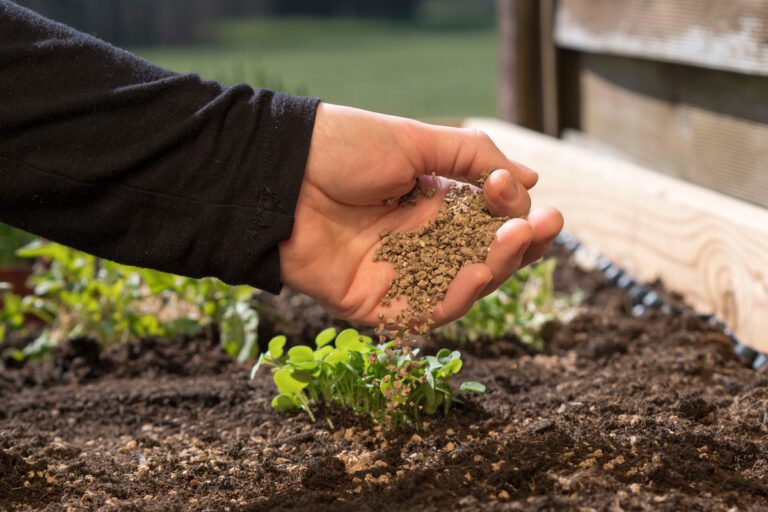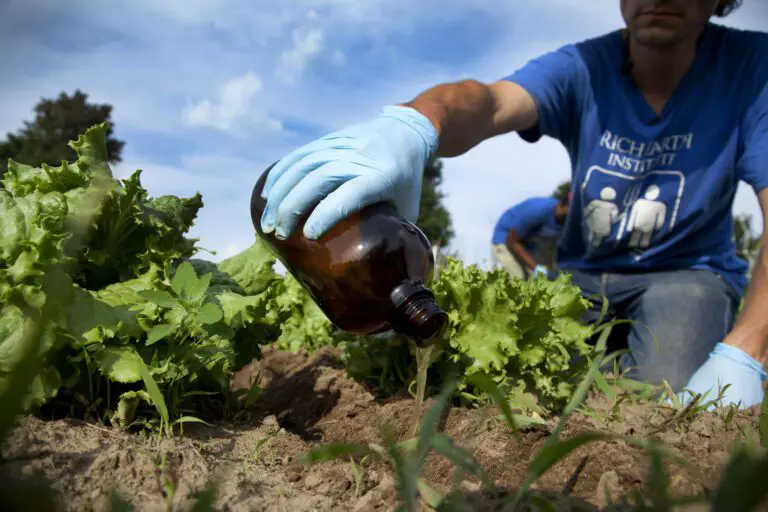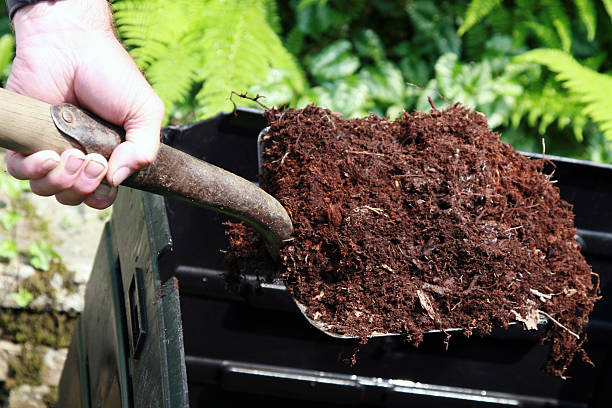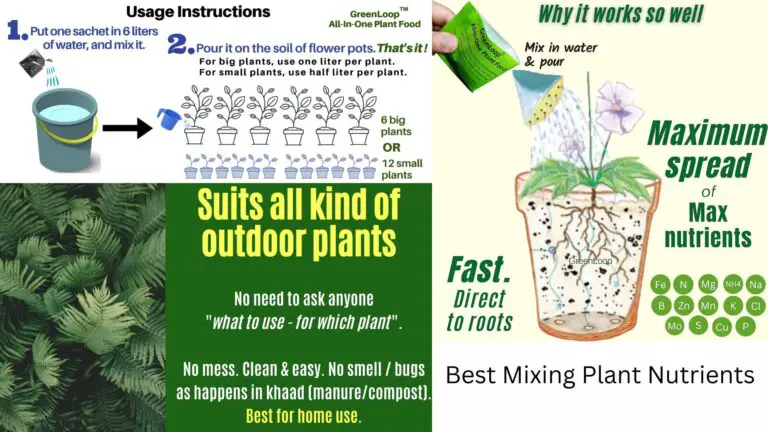Seaweed Fertilizer: Harnessing the Power of the Ocean
Table of Contents
Understanding the Benefits of Seaweed Fertilizer
Seaweed fertilizer is gaining popularity among gardening enthusiasts due to its numerous benefits for both plants and soil health. Derived from various species of seaweed, this organic fertilizer is known for its rich nutrient content and ability to enhance plant growth.
One of the key advantages of using seaweed fertilizer is its high concentration of micronutrients such as potassium, calcium, and magnesium. These essential nutrients are crucial for plant development, aiding in root formation, flower production, and overall resilience to environmental stressors. By providing plants with a readily available source of these micronutrients, seaweed fertilizer promotes healthy foliage and robust growth.
In addition to micronutrients, seaweed fertilizer also contains a range of beneficial plant hormones, including auxins, cytokinins, and gibberellins. These hormones play vital roles in various plant processes, such as cell division, root development, and flowering. By supplementing the natural hormone levels within plants, seaweed fertilizer stimulates growth and encourages overall vitality. This can result in improved resistance to diseases, better tolerance to drought, and enhanced nutrient uptake from the soil.
Moreover, seaweed fertilizer offers advantages beyond directly benefiting plants. Its application can improve soil structure and increase nutrient availability. The organic matter in seaweed acts as a soil conditioner, enhancing soil moisture retention and nutrient-holding capacity. Additionally, the presence of alginic acid, a compound found in seaweed, helps to stabilize soil aggregates and prevent soil erosion. This contributes to the overall health and productivity of the soil, creating an ideal environment for plant growth.
Overall, the benefits of seaweed fertilizer are diverse and extensive, making it a valuable tool for gardening enthusiasts seeking to improve their plant’s health and yield. From providing essential nutrients to promoting robust growth and enhancing soil health, seaweed fertilizer offers a natural and sustainable solution for nurturing healthy and thriving plants.

The Science Behind Seaweed Fertilizer
One of the key reasons why seaweed fertilizer has gained popularity among gardeners and farmers is its scientifically proven benefits. Seaweed is rich in essential nutrients, including nitrogen, phosphorus, potassium, and various trace elements. These nutrients are crucial for plant growth and development. Additionally, seaweed contains natural plant hormones called auxins, cytokinins, and gibberellins, which play a vital role in regulating plant growth, root development, and fruit production. The presence of these nutrients and hormones in seaweed fertilizer makes it an excellent supplement for promoting healthy plant growth.
Furthermore, studies have shown that the application of seaweed fertilizer can enhance plant resilience and tolerance to environmental stressors. Seaweed extracts contain a variety of bioactive compounds, such as antioxidants and plant growth-promoting substances, which can help plants cope with drought, high temperatures, salinity, and pest attacks. These compounds work at a cellular level, stimulating the plant’s natural defense mechanisms and improving its ability to withstand adverse conditions. As a result, plants treated with seaweed fertilizer are often more resistant to diseases, pests, and other environmental challenges, leading to higher yields and improved crop quality.
In conclusion, the science behind seaweed fertilizer is robust and well-documented. Its nutrient content, along with the presence of plant hormones and bioactive compounds, contributes to its effectiveness in promoting plant growth and enhancing plant resilience. The next time you’re considering fertilizing your garden or farm, consider harnessing the power of seaweed fertilizer to reap its many benefits.
Exploring the Nutrients Found in Seaweed
Seaweed fertilizer is gaining popularity among gardeners and farmers due to its rich nutrient content. Seaweed, also known as macroalgae, is a marine plant that absorbs nutrients from its surrounding environment. Consequently, seaweed fertilizer is a treasure trove of essential minerals and organic compounds that can contribute to the overall health and growth of plants.
One of the key nutrients found in seaweed fertilizer is nitrogen. Nitrogen is an essential element for plant growth as it plays a crucial role in the production of proteins and enzymes. Seaweed contains various forms of nitrogen, including nitrate, ammonium, and amino acids, which are readily available to plants. This readily available nitrogen is beneficial for both young seedlings and established plants, promoting vigorous growth and increasing overall yield.
In addition to nitrogen, seaweed fertilizer also contains a range of other nutrients, including potassium, phosphorus, calcium, and magnesium. These minerals are vital for plant development and play diverse roles in physiological processes. For instance, potassium is crucial for regulating water movement and nutrient uptake in plants, while phosphorus is necessary for energy transfer and cell division. Calcium and magnesium are essential for strengthening cell walls and promoting overall plant structure.
Moreover, seaweed fertilizer is a rich source of trace elements such as iron, manganese, zinc, and copper. These micronutrients are required in small quantities by plants but are nonetheless critical for essential metabolic functions. Iron, for instance, is crucial for chlorophyll synthesis, while zinc plays a vital role in enzyme activation. By providing these trace elements, seaweed fertilizer ensures the optimal functioning of plants and helps prevent nutrient deficiencies.
Overall, the nutrients found in seaweed fertilizer make it a valuable addition to any gardening or farming practice. By harnessing the power of these essential minerals and organic compounds, gardeners and farmers can promote the overall health and growth of their plants, leading to improved yield and quality. So, if you’re looking for a natural and nutrient-rich fertilizer, consider incorporating seaweed into your gardening toolkit.
Certainly! Let’s explore the nutrients found in seaweed. Seaweed, also known as algae, is a fascinating and nutritious food source. It plays a vital role in marine ecosystems and has been part of human diets for thousands of years, especially in Asian cuisines. Here’s a table highlighting some of the key nutrients commonly found in various types of edible seaweed:
| Type of SeaweedNutrientsCommon UsesNori– Rich in vitamins and minerals<br>- Often used for sushi rollsSushi wraps, snacksSea Lettuce– High in iron and vitamin C<br>- Resembles lettuce leavesRaw in salads, cooked in soupsKelp– Good source of iodine and calcium<br>- Gluten-free alternative to noodlesAdded to dishes during cookingKombu– Strong flavor<br>- Used for soup stockPickled or in soupArame– Mild, sweet flavor<br>- Firm textureIncorporated into various dishes, including baked goodsWakame– Used for fresh seaweed salad<br>- Cooked in stews and soupsFresh salads, stews, soupsDulse– Soft, chewy texture<br>- Adds flavor to dishesEaten as a dried snack, flavor enhancerChlorella– Green freshwater algae<br>- Often sold as a supplement in powdered formDietary supplementAgar and Carrageenan– Jelly-like substances from algae<br>- Used as plant-based binding and thickening agentsCommercially sold food products (e.g., desserts, dairy alternatives)Spirulina– Blue-green freshwater algae<br>- Available in tablet, flake, or powdered formDietary supplement |
|---|
How Seaweed Fertilizer Improves Soil Health
Seaweed fertilizer has gained popularity among gardeners and farmers alike due to its ability to improve soil health. This natural and organic fertilizer is rich in nutrients, minerals, and trace elements that enhance soil fertility and provide numerous benefits for plants. One way seaweed fertilizer improves soil health is by promoting microbial activity. The microbes present in the soil play a crucial role in breaking down organic matter and releasing essential nutrients for plant uptake. Seaweed fertilizer acts as a food source for these beneficial microbes, enhancing their population and activity. As a result, the overall microbial health of the soil improves, leading to better nutrient cycling and healthier plants.
In addition to promoting microbial activity, seaweed fertilizer also helps in improving soil structure. It contains natural hormones called auxins and cytokinins, which stimulate root growth and development. As plants take up these hormones, their root systems become stronger and more extensive, allowing for better nutrient and water absorption. This, in turn, enhances soil structure by increasing its porosity and aeration, creating an ideal environment for root growth. Improved soil structure not only benefits current plant growth but also creates a more favorable environment for future plants, ensuring long-term soil health and productivity.
Overall, seaweed fertilizer’s ability to promote microbial activity and improve soil structure makes it a valuable tool in enhancing soil health. By providing essential nutrients, stimulating microbial growth, and enhancing root development, seaweed fertilizer contributes to a thriving soil ecosystem that supports healthy plant growth. Incorporating seaweed fertilizer into gardening and farming practices can yield numerous benefits, including increased crop yields, improved plant resilience, and sustainable soil management.
Certainly! Let’s explore the nutrients found in seaweed. Seaweed, also known as algae, is a fascinating and nutritious food source. It plays a vital role in marine ecosystems and has been part of human diets for thousands of years, especially in Asian cuisines. Here’s a table highlighting some of the key nutrients commonly found in various types of edible seaweed:
| Type of Seaweed | Nutrients | Common Uses |
|---|---|---|
| Nori | – Rich in vitamins and minerals<br>- Often used for sushi rolls | Sushi wraps, snacks |
| Sea Lettuce | – High in iron and vitamin C<br>- Resembles lettuce leaves | Raw in salads, cooked in soups |
| Kelp | – Good source of iodine and calcium<br>- Gluten-free alternative to noodles | Added to dishes during cooking |
| Kombu | – Strong flavor<br>- Used for soup stock | Pickled or in soup |
| Arame | – Mild, sweet flavor<br>- Firm texture | Incorporated into various dishes, including baked goods |
| Wakame | – Used for fresh seaweed salad<br>- Cooked in stews and soups | Fresh salads, stews, soups |
| Dulse | – Soft, chewy texture<br>- Adds flavor to dishes | Eaten as a dried snack, flavor enhancer |
| Chlorella | – Green freshwater algae<br>- Often sold as a supplement in powdered form | Dietary supplement |
| Agar and Carrageenan | – Jelly-like substances from algae<br>- Used as plant-based binding and thickening agents | Commercially sold food products (e.g., desserts, dairy alternatives) |
| Spirulina | – Blue-green freshwater algae<br>- Available in tablet, flake, or powdered form | Dietary supplement |
Enhancing Plant Growth with Seaweed Fertilizer
Seaweed fertilizer offers an effective solution for enhancing plant growth and achieving healthier, more robust crops. Packed with essential nutrients and growth-promoting substances, seaweed fertilizer provides plants with a multitude of benefits. One of the primary advantages is its ability to stimulate root development, which in turn enhances nutrient uptake and overall plant health.
Moreover, studies have shown that seaweed fertilizer can increase plants’ ability to resist environmental stressors such as drought, disease, and pests. This is attributed to the presence of natural plant hormones found in seaweed, such as cytokinins and auxins, which regulate plant growth and help plants adapt to unfavorable conditions. Additionally, the high content of micro and macronutrients in seaweed fertilizer enhances the nutritional value of crops, leading to healthier and more nutritious yields.
In conclusion, utilizing seaweed fertilizer in gardening and agriculture can significantly enhance plant growth and improve overall crop health. Its ability to stimulate root development, enhance nutrient uptake, and improve resistance to stressors makes it an invaluable tool for gardeners and farmers alike. By incorporating seaweed fertilizer into their practices, plant enthusiasts can achieve healthier, more productive plants and contribute to sustainable and environmentally friendly cultivation methods.
The Environmental Impact of Seaweed Fertilizer
Seaweed fertilizer has gained popularity in recent years due to its numerous benefits for plant growth and soil health. However, it is important to consider the environmental impact of using this natural product in agriculture.
One of the key advantages of seaweed fertilizer is its minimal environmental footprint. Unlike synthetic fertilizers, which can contribute to water pollution and harm ecosystems, seaweed-based fertilizers have a lower risk of causing ecological damage. This is because seaweed is a renewable resource that can be sustainably harvested from the ocean without depleting natural habitats. Additionally, seaweed-derived fertilizers are often biodegradable, breaking down naturally in the soil over time without leaving harmful residues behind.
Furthermore, the use of seaweed fertilizer can actually help mitigate certain environmental challenges. For example, seaweed farming can absorb and remove excess nutrients, such as nitrogen and phosphorus, from the water. These nutrients, if left unchecked, can lead to harmful algal blooms and oxygen depletion in aquatic environments. By cultivating seaweed for fertilizer production, we can effectively recycle these nutrients and prevent their negative impact on surrounding ecosystems.

Different Types of Seaweed Used for Fertilizer
Seaweed, commonly known as marine algae, is a nutrient-rich plant that has been used as a natural fertilizer for centuries. However, not all types of seaweed are suitable for use in fertilizer production. There are a few key varieties that are particularly valued for their nutrient content and beneficial properties.
One of the most popular types of seaweed used for fertilizer is Ascophyllum nodosum, also known as knotted wrack. This species is abundant in the North Atlantic and is rich in essential plant nutrients such as nitrogen, phosphorus, and potassium. It also contains a wide range of trace elements, vitamins, and hormones that promote healthy plant growth and development.
Another commonly utilized seaweed is Sargassum, which is found in warmer coastal waters. This type of seaweed is known for its high levels of potassium and calcium, making it especially beneficial for plants that require these nutrients. Sargassum also contains natural growth hormones called auxins, which help stimulate root growth and improve overall plant health.
Kelp, a type of brown seaweed, is another valuable seaweed used for fertilizer. It is abundant along coastal areas and is recognized for its high iodine and iron content. Kelp is rich in plant growth hormones called cytokinins, which promote cell division and enhance nutrient absorption in plants.
Overall, these different types of seaweed offer a range of nutrients and beneficial compounds that can contribute to healthier plants and improved crop yields. Their natural properties make them a popular choice for organic and sustainable agriculture, as they provide an alternative to synthetic fertilizers while promoting soil health and reducing environmental impacts.
Certainly! Let’s explore the different types of seaweed used for fertilizer. Seaweed, also known as algae, not only benefits marine ecosystems but also plays a crucial role in agriculture. Here are some common types of seaweed and their applications as organic fertilizers:
- Liquid Seaweed Fertilizer:
- Derived from various seaweed species such as kelp, bladderwrack, Irish moss, and dulse.
- Rich in essential nutrients like nitrogen, potassium, and trace minerals.
- Enhances soil fertility, promotes plant growth, and improves overall plant health .
- Seaweed/Kelp Meal:
- Prepared by drying and grinding seaweed.
- Contains macro and micronutrients, including iodine, calcium, and magnesium.
- Used as a soil conditioner and nutrient supplement .
- Seaweed Extract Powder:
- Produced by heating seaweed and then grinding it into a fine powder.
- Contains plant growth hormones, vitamins, and minerals.
- Boosts plant vigor, root development, and stress tolerance .
- Calcified Seaweed:
- Seaweed treated with lime or calcium.
- Provides calcium and other essential elements to plants.
- Improves soil structure and nutrient availability .
- Red Seaweed (Rhodophyta):
- Grows in warm and tropical waters.
- Used as a biofertilizer due to its unique nutrient composition.
- Enhances soil health and supports crop growth .
- Green Seaweed (Chlorophyta):
- Thrives in colder waters.
- High in chlorophyll, amino acids, and vitamins.
- Beneficial for soil enrichment and plant vitality .
- Brown Seaweed (Phaeophyceae):
- Contains alginates, mannitol, and minerals.
- Used as a soil conditioner and natural fertilizer .
Harvesting and Processing Seaweed for Fertilizer Production
The harvesting and processing of seaweed for fertilizer production is a crucial step in the overall production process. Seaweed is typically harvested from coastal areas, where it grows abundantly in the nutrient-rich waters. Various methods are used to harvest seaweed, including hand harvesting, mechanical harvesting, and even the use of specially designed boats and equipment.
Once the seaweed is harvested, it needs to be processed to transform it into a usable fertilizer. This involves several steps, including washing, drying, and grinding the seaweed into a fine powder. The powder can then be further processed to extract specific nutrients or compounds, depending on the desired fertilizer formulation.
Harvesting and processing seaweed for fertilizer production requires careful attention to detail and adherence to strict quality control standards. This ensures that the final product is of high quality and contains the necessary nutrients to benefit plants. Additionally, sustainable harvesting practices are paramount to protect and preserve the delicate marine ecosystems where seaweed grows. Maintaining the balance between seaweed production and environmental conservation is essential for the long-term viability of seaweed fertilizer production.
The Role of Seaweed Fertilizer in Sustainable Agriculture
Seaweed fertilizer has emerged as a valuable tool in sustainable agriculture, revolutionizing the way we cultivate crops and promote soil health. One of the key roles of seaweed fertilizer lies in its ability to enhance the fertility and structure of soil. The rich array of nutrients present in seaweed, including nitrogen, phosphorus, potassium, and a variety of trace minerals, provide a natural and nutritious supplement for plants. These nutrients not only support robust plant growth but also contribute to the overall health and vitality of the soil ecosystem.
Furthermore, the role of seaweed fertilizer extends beyond its nutrient content. Seaweed contains naturally occurring growth hormones such as auxins, cytokinins, and gibberellins, which regulate various physiological processes in plants. By promoting cell division, elongation, and differentiation, these hormones contribute to increased root development, stronger stems, and improved nutrient uptake efficiency. This translates into healthier plants that are more resilient to environmental stressors such as drought, diseases, and pests. Seaweed fertilizer’s role in sustainable agriculture is multifaceted, combining the benefits of nutrient enrichment and hormonal stimulation to promote sustainable and environmentally friendly crop production systems.
Seaweed Fertilizer as an Organic Alternative
Seaweed fertilizer has gained significant attention in recent years as an organic alternative to traditional synthetic fertilizers. With growing concerns about the environmental impact of chemical fertilizers, many gardeners and farmers are turning to seaweed as a natural and sustainable option for nourishing their plants.
One of the key benefits of seaweed fertilizer is its rich nutrient content. Seaweed contains a wide range of essential nutrients, including nitrogen, phosphorus, potassium, and trace elements like iron, manganese, and zinc. These nutrients are crucial for plant growth and development, and seaweed fertilizer provides them in a readily available form. Additionally, seaweed is a natural source of growth hormones and bioactive compounds that promote plant health and resilience.
In addition to its nutrient content, seaweed fertilizer offers other advantages as well. It helps improve soil structure by enhancing its water-holding capacity and promoting the growth of beneficial microorganisms. This, in turn, leads to improved root development and nutrient uptake by plants. Furthermore, the use of seaweed fertilizer has been found to stimulate plant growth, increase crop yields, and enhance the overall quality of produce.
Tips for Proper Application of Seaweed Fertilizer
Proper application of seaweed fertilizer is essential to maximize its benefits for your plants and ensure optimal results. Here are a few tips to help you make the most of this organic alternative:
1. Dilution is key: Before applying seaweed fertilizer, it is important to dilute it with water according to the manufacturer’s instructions. This will prevent any potential burn or damage to your plants and ensure that the nutrients are evenly distributed.
2. Timing is crucial: Seaweed fertilizer is most effective when applied during the active growing season of your plants. By timing your applications to coincide with periods of rapid growth, you can provide the necessary boost of nutrients and enhance plant development.
3. Apply at the roots: To ensure that your plants receive the maximum benefit, it is recommended to apply seaweed fertilizer directly to the root zone. This can be done by gently pouring the diluted solution around the base of the plant, allowing for efficient absorption.
4. Use as a foliar spray: In addition to root application, seaweed fertilizer can also be used as a foliar spray. This method involves spraying a diluted solution onto the leaves of the plant, allowing for direct nutrient absorption. However, it is important to avoid spraying during the hottest part of the day to prevent leaf scorch.
Remember, every plant is unique, and factors such as plant type, soil conditions, and climate can influence the effectiveness of seaweed fertilizer. It is always recommended to start with small doses and monitor your plants’ response before increasing the application.
Maximizing Crop Yields with Seaweed Fertilizer
Seaweed fertilizer has gained popularity among farmers and gardeners alike due to its ability to maximize crop yields. Unlike traditional chemical fertilizers, seaweed fertilizer offers a natural and organic solution that promotes healthy plant growth and increases overall productivity.
One of the key benefits of using seaweed fertilizer to maximize crop yields is its high nutrient content. Seaweed is rich in essential elements like nitrogen, phosphorus, and potassium, which are crucial for plant growth and development. Additionally, seaweed contains numerous trace elements such as iron, calcium, and magnesium, which are necessary for overall plant health. These nutrients are readily available in a form that is easily absorbed by plants, ensuring efficient nutrient uptake and utilization.
Moreover, seaweed fertilizer also enhances soil health, further contributing to increased crop yields. The organic matter present in seaweed helps improve soil structure, promoting better water retention and drainage. It also encourages the growth of beneficial soil microorganisms, which aid in nutrient cycling and disease suppression. As a result, plants grown in soil amended with seaweed fertilizer have improved root development, leading to stronger, healthier plants that are more resilient to stressors such as drought and disease.
With its rich nutrient composition and positive impact on soil health, seaweed fertilizer has become an invaluable tool for maximizing crop yields. Its organic nature and environmentally friendly characteristics make it an attractive option for farmers and gardeners looking to achieve sustainable and high-quality crop production. By harnessing the beneficial properties of seaweed fertilizer, growers can unlock the full potential of their plants and ensure abundant harvests year after year.
Case Studies: Successful Implementation of Seaweed Fertilizer
Case studies provide valuable insights into the successful implementation of seaweed fertilizer in various agricultural settings. These real-life examples demonstrate the positive impact of seaweed fertilizer on crop growth, yield, and overall plant health.
One case study conducted on tomato plants in a greenhouse setting showed promising results. The application of seaweed fertilizer resulted in increased plant height, stem diameter, and leaf area compared to plants not treated with seaweed fertilizer. Additionally, the treated plants exhibited enhanced root development, which is crucial for nutrient absorption and overall plant health. The study concluded that seaweed fertilizer can significantly improve the growth and quality of tomato plants, making it a valuable tool for greenhouse growers.
Another case study focused on the use of seaweed fertilizer in organic lettuce production. The study found that the application of seaweed fertilizer not only increased lettuce yield but also improved the nutritional content of the harvested leaves. Lettuce plants treated with seaweed fertilizer showed higher levels of essential nutrients such as vitamins C and E, as well as minerals like iron and zinc. This demonstrates the potential of seaweed fertilizer to not only enhance crop yield but also improve the nutritional value of the harvested produce.
These case studies highlight the successful implementation of seaweed fertilizer in different agricultural contexts. The evidence strongly suggests that seaweed fertilizer can contribute to the overall sustainability and productivity of agricultural systems. By harnessing the power of seaweed, farmers and growers can potentially unlock the full potential of their crops while promoting environmentally friendly practices.
Overcoming Challenges in Seaweed Fertilizer Usage
One of the challenges in using seaweed fertilizer is determining the appropriate dosage for different plants and soil types. While seaweed is generally safe and beneficial for plant growth, excessive application can lead to nutrient imbalance and potential harm to the ecosystem. It is crucial for gardeners to carefully follow the instructions provided by the manufacturer and perform soil tests to identify the specific needs of their plants. This will ensure that the seaweed fertilizer is used in the correct amounts, maximizing its benefits without causing any adverse effects.
Another challenge is sourcing high-quality seaweed fertilizer. With the growing popularity of seaweed as a natural fertilizing option, there has been an increase in the availability of products in the market. However, not all seaweed fertilizers are created equal. Some may contain impurities or insufficient nutrient content, which can diminish their effectiveness. It is essential for gardeners to research and select reputable brands that adhere to strict manufacturing standards and source their seaweed from clean and sustainable environments. By investing in quality seaweed fertilizer, gardeners can overcome this challenge and reap the full benefits of this organic fertilizing solution.
Seaweed Fertilizer and its Potential in Ecosystem Restoration
Seaweed fertilizer has gained significant attention for its potential in ecosystem restoration. Ecosystems around the world are facing various challenges, such as soil erosion, pollution, and loss of biodiversity. Seaweed fertilizer offers a promising solution due to its ability to enhance soil health and stimulate plant growth.
One of the key benefits of seaweed fertilizer in ecosystem restoration is its rich nutrient content. Seaweed is known to contain essential elements like nitrogen, phosphorus, and potassium, along with trace minerals and growth-promoting substances such as auxins, cytokinins, and gibberellins. When applied to degraded soils or areas with low nutrient availability, seaweed fertilizer can replenish the soil with these vital nutrients and create a favorable environment for plant growth.
Moreover, seaweed fertilizer offers additional advantages for ecosystem restoration. It can improve soil structure, enhance water-holding capacity, and increase microbial activity. These factors contribute to the development of healthier soils, which in turn support the growth of diverse plant species. As plants thrive, they contribute to the stability and resilience of ecosystems, helping to prevent soil erosion, restore habitats, and promote biodiversity.
Seaweed fertilizer’s potential in ecosystem restoration is becoming increasingly recognized and studied by scientists and environmentalists. Continued research and experimentation are essential to fully understand its capabilities and practical applications. By harnessing the power of seaweed fertilizer, we can take significant strides in restoring and preserving our precious ecosystems for future generations.

The Future of Seaweed Fertilizer: Opportunities and Innovations
The future of seaweed fertilizer holds great promise as innovative opportunities and advancements continue to emerge in the field of agriculture. Researchers and scientists are exploring novel methods to extract and process seaweed to maximize its potential as a fertilizer. One such innovation is the development of seaweed-based biostimulants, which are believed to enhance plant growth and improve crop yields.
Additionally, ongoing research is focusing on uncovering the specific mechanisms by which seaweed fertilizer benefits soil health and plant growth. This deeper understanding will enable scientists to optimize its application and dosage for different crops and environmental conditions. Moreover, advancements in technology and machinery used for the harvesting and processing of seaweed are expected to streamline production and make seaweed fertilizer more easily accessible to farmers.
In conclusion, the future of seaweed fertilizer is full of opportunities and innovations that have the potential to revolutionize sustainable agriculture. As more knowledge is gained and new techniques are developed, we can expect to see even greater benefits from incorporating seaweed fertilizer into farming practices. By harnessing the power of this natural and renewable resource, we can cultivate healthier soils, increase crop productivity, and contribute to a more environmentally friendly and sustainable food production system.
What are the main benefits of using seaweed fertilizer?
Seaweed fertilizer provides numerous benefits, such as enhancing soil health, improving plant growth, and increasing crop yields. It also serves as a natural and organic alternative to synthetic fertilizers.
How does seaweed fertilizer improve soil health?
Seaweed fertilizer enriches the soil by adding essential nutrients, improving its structure, and promoting beneficial microorganisms. It helps retain moisture, prevents soil erosion, and enhances its overall fertility.
What nutrients can be found in seaweed fertilizer?
Seaweed fertilizer contains a wide range of nutrients, including nitrogen, potassium, phosphorus, calcium, magnesium, and various trace elements such as iron, zinc, and manganese. It also contains natural growth hormones like auxins, cytokinins, and gibberellins.
Is seaweed fertilizer suitable for organic farming?
Yes, seaweed fertilizer is an excellent choice for organic farming as it is derived from natural sources and does not contain any synthetic chemicals or harmful residues.
How should seaweed fertilizer be applied for maximum effectiveness?
Seaweed fertilizer can be applied as a foliar spray or directly to the soil. It is recommended to dilute it according to the manufacturer’s instructions and apply it during the early morning or late afternoon to avoid sunburn on plant leaves.
Can seaweed fertilizer be used in all types of agriculture?
Yes, seaweed fertilizer can be used in various types of agriculture, including conventional farming, organic farming, hydroponics, and greenhouse cultivation. It is suitable for both small-scale and large-scale farming operations.
Are there different types of seaweed used for fertilizer production?
Yes, there are several types of seaweed that are commonly used for fertilizer production, including kelp, bladderwrack, rockweed, and sea lettuce. Each type may have slightly different nutrient profiles and beneficial properties.
What are some potential innovations in seaweed fertilizer?
The future of seaweed fertilizer holds exciting opportunities for innovation. Some potential developments include the use of seaweed extracts in seed coatings, the development of specialized formulations for specific crops, and the integration of seaweed into precision agriculture technologies.
How can seaweed fertilizer contribute to ecosystem restoration?
Seaweed fertilizer has the potential to play a significant role in ecosystem restoration. By enhancing soil health and promoting plant growth, it can help rehabilitate degraded lands, stabilize coastlines, and support the recovery of marine ecosystems.
Can you provide examples of successful implementation of seaweed fertilizer?
Yes, there have been several successful case studies highlighting the benefits of seaweed fertilizer. For example, in coastal regions of Ireland, the use of seaweed-based fertilizers has improved soil fertility and increased crop yields. In Japan, seaweed fertilizers have been utilized for centuries in rice cultivation, leading to improved soil conditions and higher rice production.







